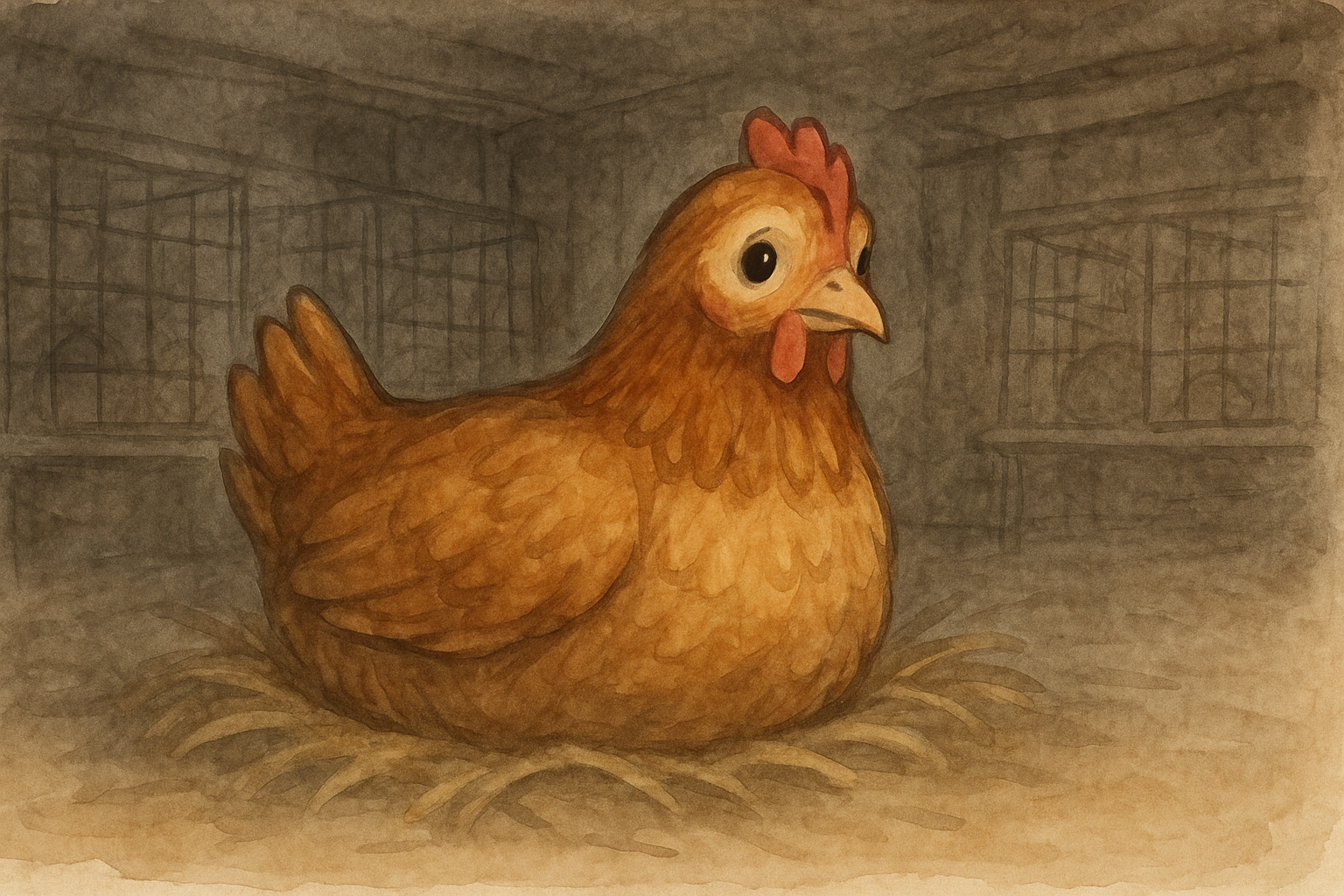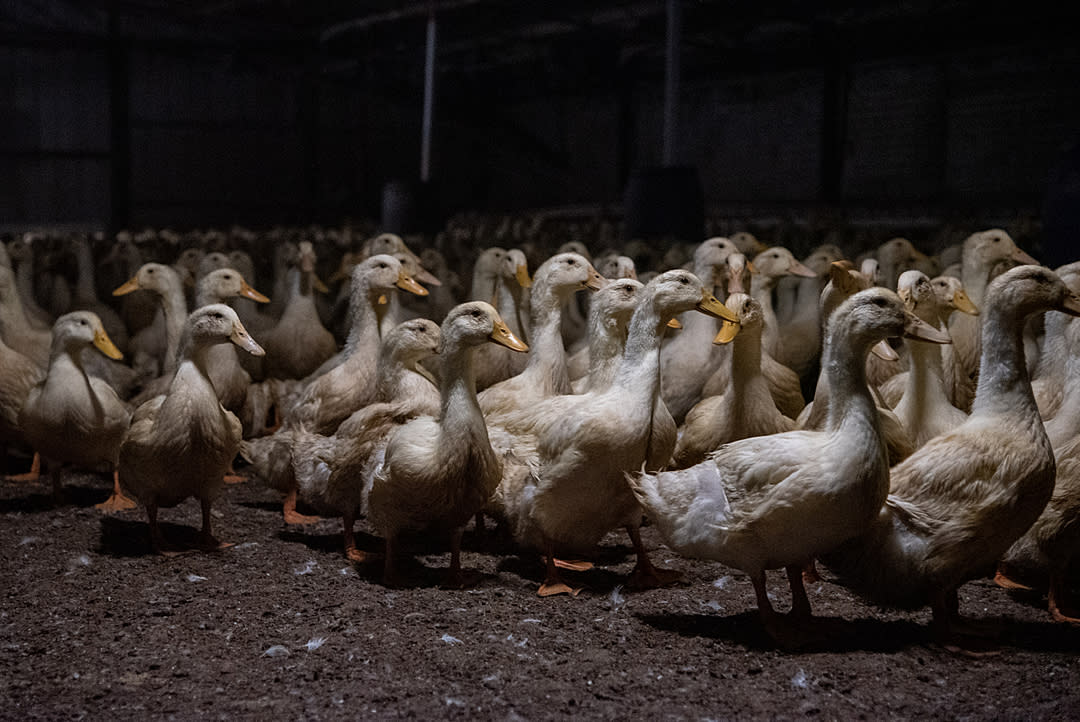




One of the arguments for consuming eggs is that laying eggs is a natural process so it doesn’t harm hens. But is this true?

Laying eggs should not normally be painful for hens.
Unfortunately, for many of the over 300 million birds who produce eggs in the US, laying eggs can cause them to suffer.
The toll that laying eggs takes on the bodies of these mother birds is immense, due to the sheer number of eggs they now produce. Making matters worse are the conditions so many hens are forced to endure while laying eggs, many inside cramped cages, devoid of privacy and proper conditions to nest.
What makes egg-laying hurt hens?
The industrialization of egg production has meant that producers have focused on profit, forcing hens to lay many more eggs than is natural. This causes painful keel fractures common among layer hens, along with another medical issue known as prolapsed cloaca. This is when part of the hen’s internal egg duct comes out of her body, remaining exposed.
Anatomy and psychology of egg-laying hens
Hens lay eggs whether they’re fertilized or not. Sometimes a mother hen will lay and then walk away, other times she may become protective and attempt to hatch it—again, whether fertilized or not. Some hens may also eat their eggs when in need of calcium.
Regardless of what she does with her eggs, producing them does take a toll on her body. That’s part of the reason why hens on factory farms tend to have brittle bones. So much of the calcium she consumes goes toward forming egg shells that there’s not much left to strengthen her body.
How are eggs made?
It takes about 25 hours for a chicken to make an egg, meaning they tend to lay about one egg per day. Over that time, the egg is slowly layered together, with the shell taking up 19 hours of that time to form. First, the yolk is released and transported through the oviduct. Then the white is added. It’s at this point that the shell membrane and shell form. Finally, the bloom is formed, which acts as a natural protective layer.
How often do chickens lay eggs?
Laying roughly one egg per day on factory farms is a staggering number compared to the roughly 20 eggs per year laid by chickens’ closest wild relative, the red junglefowl.
Intensive breeding and light manipulation on farms are used to force hens to lay so many eggs. Like chickens raised for meat who have been bred to grow very large, very quickly, layer hens have also been bred with a focus on maximizing productivity. This means they are made to lay as many eggs as possible in a short period of time.
Hens are also highly sensitive to day length, naturally laying more eggs during the long summer days when chicks are more likely to survive. Farmers exploit this by keeping sheds lit for long hours all throughout the year, to keep the birds laying at maximum capacity.
How to tell if a chicken is in pain
Though they’re often considered little more than egg-laying machines, hens do experience pain. Chickens who are in pain are likely to spend more time laying down and not moving around.
How long does it take a hen to push out an egg?
While it takes a little more than a day for an egg to form and be laid, actually pushing out the egg happens much more quickly, assuming it doesn’t get stuck. In fact, it takes less than a minute for the egg to travel out of the cloaca.
Can a large egg get stuck in a chicken?
An egg can get stuck inside a chicken due to a condition called egg binding. Poor nutrition is one of the most common reasons chickens become egg-bound, but young chickens, and chickens who lay a lot of eggs, are also at an increased risk. If not treated quickly, the condition is fatal.
Do chickens feel bad when you take their eggs?
Hens can sometimes become broody, meaning protective over their eggs. That’s because they’re getting ready to sit on them until they hatch. Broody hens will stop laying eggs and spend more time in their nests. For producers, this is a problem, meaning access is often limited.
In the case of fertilized eggs, mother hens will start to communicate with their chicks even before they hatch. In fact, when unhatched chicks cry out in distress, the mother hen will come back to the nest to tend to them. This communication helps establish the parental bond even before the baby birds hatch.
Chickens in the egg industry
Contrary to the happy hens portrayed on egg cartons in supermarkets, the egg industry is not a pleasant place for birds. Instead of enjoying the outdoors and engaging in natural behaviors, most factory-farmed hens spend their short lives laying eggs at the expense of their bodies, in crowded, unfulfilling conditions.
The egg industry and factory farming
Factory farms are currently an integral part of the egg industry. A typical egg farm contains several large sheds, which contain thousands of hens. While sometimes those birds are able to walk around on the floor of the barns or outside—in organic systems, for example—hens are still often confined to “enriched” cages.
Common factory farming practices in the egg industry
Common practices in the factory farming industry are shocking due to their brutality. Whether related to how birds are handled, housed, or raised, every decision is made with the goal of increasing profit, often to the detriment of the birds.
Battery cages
Battery cages are common on farms. These cages don’t even provide each bird with enough space to stretch their wings. Battery cages remain common on egg farms in the US. In other countries, where battery cages have been banned, so-called “enriched cages” only provide hens with marginally more space are still widely used.
Chick culling
Because they can’t lay eggs, male chicks born within the egg industry are killed hours after they’re hatched. In the US, chicks are usually macerated. In other parts of the world, they can be suffocated, electrocuted, gassed to death, or have their necks broken by hand.
Forced molting
Chickens naturally molt in order to grow new, warmer feathers ahead of the winter. This process involves decreased eating, dropping feathers, and not laying eggs. On farms, chickens are starved to force their bodies to start the molting process, regardless of their natural inclinations. This forced molting is done when egg productivity begins to drop, as afterward the birds are known to start laying again, producing a higher number of larger eggs.
Debeaking
Debeaking is another term for beak trimming, which is the practice of cutting off the tip of a chick’s beak with a hot blade. This is done due to the stressful environment of egg farms increasing pecking and bullying among birds. If birds have their beaks trimmed, they can’t do as much damage to one another.
Are chickens smart?
Chickens are amazing creatures. From the moment they hatch they can count up to five. As adults they have object permanence, meaning they can tell when something is hidden versus gone—a skill even two-year old human children lack.
The bottom line
The egg industry is filled with unnecessary suffering. From the male chicks killed at just a few hours old, to the conditions and confinement that hens are forced to endure.
If you’d like to leave eggs off your plate, there are many egg-free alternatives for all of your favorite dishes.
If you’d like to join our fight against cages, click here to take action in our campaigns.





